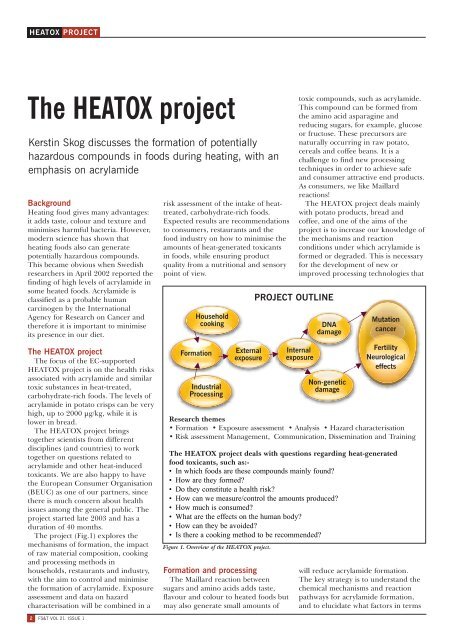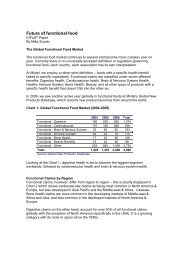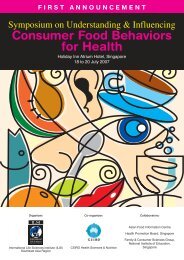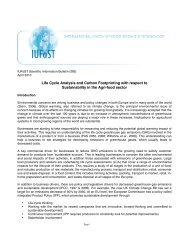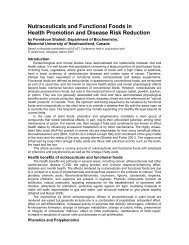The HEATOX project - World Food Science
The HEATOX project - World Food Science
The HEATOX project - World Food Science
You also want an ePaper? Increase the reach of your titles
YUMPU automatically turns print PDFs into web optimized ePapers that Google loves.
<strong>HEATOX</strong> PROJECT<br />
<strong>The</strong> <strong>HEATOX</strong> <strong>project</strong><br />
Kerstin Skog discusses the formation of potentially<br />
hazardous compounds in foods during heating, with an<br />
emphasis on acrylamide<br />
Background<br />
Heating food gives many advantages:<br />
it adds taste, colour and texture and<br />
minimises harmful bacteria. However,<br />
modern science has shown that<br />
heating foods also can generate<br />
potentially hazardous compounds.<br />
This became obvious when Swedish<br />
researchers in April 2002 reported the<br />
finding of high levels of acrylamide in<br />
some heated foods. Acrylamide is<br />
classified as a probable human<br />
carcinogen by the International<br />
Agency for Research on Cancer and<br />
therefore it is important to minimise<br />
its presence in our diet.<br />
<strong>The</strong> <strong>HEATOX</strong> <strong>project</strong><br />
<strong>The</strong> focus of the EC-supported<br />
<strong>HEATOX</strong> <strong>project</strong> is on the health risks<br />
associated with acrylamide and similar<br />
toxic substances in heat-treated,<br />
carbohydrate-rich foods. <strong>The</strong> levels of<br />
acrylamide in potato crisps can be very<br />
high, up to 2000 µg/kg, while it is<br />
lower in bread.<br />
<strong>The</strong> <strong>HEATOX</strong> <strong>project</strong> brings<br />
together scientists from different<br />
disciplines (and countries) to work<br />
together on questions related to<br />
acrylamide and other heat-induced<br />
toxicants. We are also happy to have<br />
the European Consumer Organisation<br />
(BEUC) as one of our partners, since<br />
there is much concern about health<br />
issues among the general public. <strong>The</strong><br />
<strong>project</strong> started late 2003 and has a<br />
duration of 40 months.<br />
<strong>The</strong> <strong>project</strong> (Fig.1) explores the<br />
mechanisms of formation, the impact<br />
of raw material composition, cooking<br />
and processing methods in<br />
households, restaurants and industry,<br />
with the aim to control and minimise<br />
the formation of acrylamide. Exposure<br />
assessment and data on hazard<br />
characterisation will be combined in a<br />
risk assessment of the intake of heattreated,<br />
carbohydrate-rich foods.<br />
Expected results are recommendations<br />
to consumers, restaurants and the<br />
food industry on how to minimise the<br />
amounts of heat-generated toxicants<br />
in foods, while ensuring product<br />
quality from a nutritional and sensory<br />
point of view.<br />
Household<br />
cooking<br />
Formation<br />
Industrial<br />
Processing<br />
External<br />
exposure<br />
Formation and processing<br />
<strong>The</strong> Maillard reaction between<br />
sugars and amino acids adds taste,<br />
flavour and colour to heated foods but<br />
may also generate small amounts of<br />
PROJECT OUTLINE<br />
toxic compounds, such as acrylamide.<br />
This compound can be formed from<br />
the amino acid asparagine and<br />
reducing sugars, for example, glucose<br />
or fructose. <strong>The</strong>se precursors are<br />
naturally occurring in raw potato,<br />
cereals and coffee beans. It is a<br />
challenge to find new processing<br />
techniques in order to achieve safe<br />
and consumer attractive end products.<br />
As consumers, we like Maillard<br />
reactions!<br />
<strong>The</strong> <strong>HEATOX</strong> <strong>project</strong> deals mainly<br />
with potato products, bread and<br />
coffee, and one of the aims of the<br />
<strong>project</strong> is to increase our knowledge of<br />
the mechanisms and reaction<br />
conditions under which acrylamide is<br />
formed or degraded. This is necessary<br />
for the development of new or<br />
improved processing technologies that<br />
Internal<br />
exposure<br />
DNA<br />
damage<br />
Non-genetic<br />
damage<br />
Mutation<br />
cancer<br />
Fertility<br />
Neurological<br />
effects<br />
Research themes<br />
• Formation • Exposure assessment • Analysis • Hazard characterisation<br />
• Risk assessment Management, Communication, Dissemination and Training<br />
<strong>The</strong> <strong>HEATOX</strong> <strong>project</strong> deals with questions regarding heat-generated<br />
food toxicants, such as:-<br />
• In which foods are these compounds mainly found?<br />
• How are they formed?<br />
• Do they constitute a health risk?<br />
• How can we measure/control the amounts produced?<br />
• How much is consumed?<br />
• What are the effects on the human body?<br />
• How can they be avoided?<br />
• Is there a cooking method to be recommended?<br />
Figure 1. Overview of the <strong>HEATOX</strong> <strong>project</strong>.<br />
will reduce acrylamide formation.<br />
<strong>The</strong> key strategy is to understand the<br />
chemical mechanisms and reaction<br />
pathways for acrylamide formation,<br />
and to elucidate what factors in terms<br />
2<br />
FS&T VOL 21. ISSUE 1
<strong>HEATOX</strong> PROJECT<br />
of reaction conditions and chemical<br />
composition influence these reactions.<br />
A database containing 570<br />
compounds that can be formed in<br />
simple amino acid-sugar reaction<br />
systems has been compiled. This<br />
information can be used by<br />
toxicologists for defining heat-derived<br />
compounds that may be considered as<br />
potentially harmful.<br />
<strong>The</strong> kinetics behind the formation<br />
and loss of acrylamide during heating<br />
of low moisture model systems, e.g.<br />
potato cakes, has been studied. It was<br />
found that long heating times resulted<br />
in a tremendous loss in acrylamide.<br />
Higher temperature for coffee<br />
roasting yielded lower levels of<br />
acrylamide, and interestingly, high<br />
concentrations of sugars in coffee<br />
beans correlated with lower<br />
concentrations of acrylamide after<br />
roasting.<br />
<strong>The</strong> limiting factor for formation of<br />
acrylamide in bread is asparagine,<br />
which is mainly concentrated in the<br />
cereal bran. This means that bread<br />
made from flour rich in dietary fibre<br />
will contain more acrylamide than<br />
bread from sifted flour. However, new<br />
fermentation techniques could<br />
degrade the asparagine and thus<br />
lower the acrylamide content. New<br />
baking techniques such as air jet<br />
impingement and infrared radiation<br />
baking seem promising and the effect<br />
on sensory quality, bread crust and<br />
acrylamide formation is under<br />
investigation.<br />
A mind map was created to get an<br />
overview of factors affecting<br />
acrylamide formation during potato<br />
processing. <strong>The</strong>n a fry simulator, i.e. a<br />
computer program, was developed<br />
based on oil temperature, sugar and<br />
asparagine concentrations. <strong>The</strong> fry<br />
simulator can be applied to new and<br />
improved processing technologies to<br />
evaluate acrylamide formation and<br />
quality of the product. So far, the most<br />
crucial parts seem to be the corners of<br />
French fries.<br />
<strong>The</strong> effect of storage conditions on<br />
sugar development and acrylamide<br />
formation has been studied for<br />
different potato varieties. It was found<br />
that low storage temperatures<br />
increased the sugar content as well as<br />
the acrylamide content. However,<br />
potato varieties adapted to cold<br />
storage had lower sugar content and<br />
for some varieties, the level of<br />
asparagine seemed to be important for<br />
acrylamide formation. Work has also<br />
been undertaken on home-cooked<br />
potatoes, for example, the effect of<br />
frying in a commercially-available<br />
domestic fryer on acrylamide<br />
formation. When the potato sticks<br />
were put in the fryer, the oil<br />
temperature dropped drastically and<br />
slowly reached its original<br />
temperature. At that time, high levels<br />
of acrylamide were found. <strong>The</strong> drop<br />
in temperature depends of the<br />
product/oil ratio and this makes it<br />
difficult to define an initial oil<br />
temperature as a measure to reduce<br />
acrylamide.<br />
Analysis<br />
Adequate analysis is a prerequisite<br />
for reliable results. A variety of<br />
analytical techniques for different<br />
heat-induced toxic compounds in<br />
foods and precursors, along with<br />
analytical techniques for adducts and<br />
metabolites in humans and animals,<br />
have been developed. Special focus<br />
has been on high-intake foods like<br />
bread and infant food for which low<br />
determination limits are needed for<br />
intake estimates, and also difficult<br />
matrices which are estimated to<br />
account for up to 30% of the<br />
acrylamide exposure in some<br />
countries.<br />
Different analytical methods for<br />
acrylamide, furan and HMF (5-<br />
hydroxy-methylfurfural) in different<br />
types of foods have been investigated.<br />
Regarding acrylamide analysis, an<br />
improved extraction procedure for<br />
both clean-up and sample preconcentration<br />
has been developed,<br />
and comparison between several<br />
analysers for LC-MS/MS methods has<br />
been performed. <strong>The</strong> influence of<br />
high pH on the release of acrylamide<br />
during water extraction of food<br />
samples has been studied. Several of<br />
the partners in the <strong>project</strong> have access<br />
to sophisticated analytical equipment<br />
and techniques, such as HR-GC-TOF-<br />
MS (High Resolution Gas<br />
Chromatography Time-of-Flight Mass<br />
Spectrometry), LC-MS/MS, NMR,<br />
AMS (Accelerator mass spectrometry)<br />
and a flow cytometer-based<br />
micronucleus assay for human<br />
erythrocytes.<br />
Cooking practices and dietary habits<br />
vary between countries and food<br />
samples have been analysed in<br />
connection with exposure assessment,<br />
for example, foods for which literature<br />
data is insufficient. This includes<br />
ethnic foods, foods for specific risk<br />
groups (e.g. children), home-cooked<br />
foods and foods where reliable data<br />
are missing due to limitations of the<br />
analytical methods. To get refined<br />
dietary exposure estimates, samples of<br />
ready-to-eat meals prepared from<br />
frozen and similar pre-prepared<br />
products have also been examined.<br />
Thus, data on acrylamide levels for<br />
exposure estimates have been<br />
obtained from different countries<br />
within the <strong>project</strong>.<br />
A literature search for known<br />
cooked-food toxicants and other<br />
potential hazardous substances that<br />
could be formed in thermal processing<br />
of foods has been performed, and a<br />
preliminary QSAR (quantitative<br />
structure-activity relationship)<br />
assessment of a large number of<br />
browning reaction products has been<br />
conducted.<br />
Hazard characterisation<br />
Knowledge of the dose-effect<br />
function, including the bioavailability<br />
of heat-induced toxicants in food, is<br />
important. Bioavailability is measured<br />
with different biomarkers, i.e.<br />
different adducts. A number of<br />
different studies have been<br />
performed, not only on acrylamide<br />
but also on HMF and other heatinduced<br />
compounds and a few of<br />
them are commented upon below.<br />
Progress has been made in the use<br />
of AMS in the determination of<br />
acrylamide, acrylamide metabolites<br />
and DNA-adducts at the very low<br />
concentrations corresponding to<br />
human exposure levels, and a good<br />
dose response relationship was<br />
obtained for DNA adducts.<br />
<strong>The</strong> potency of different heatinduced<br />
toxicants has been studied in<br />
the micronucleus assay in mice.<br />
<strong>The</strong> results indicate that some heatinduced<br />
toxicants show both stronger<br />
and lower potency compared with<br />
3
<strong>HEATOX</strong> PROJECT<br />
acrylamide. It raises the question of<br />
how quantitative data on potency could<br />
be used in risk assessment.<br />
Animal experiments on neurodevelopmental<br />
toxicity showed that the<br />
developing brain is particularly<br />
susceptible to acrylamide exposure,<br />
which causes persistent changes in<br />
behaviour in mice, a finding with<br />
important impact on human hazard<br />
assessment.<br />
Exposure assessment<br />
Monte Carlo Risk Analyses software is<br />
a probabilistic model originally made<br />
for exposure assessment of pesticide<br />
residues. <strong>The</strong> model has been<br />
extended and optimised to perform<br />
‘what-if scenarios’ using acrylamide<br />
concentration data. A few ‘what-if<br />
scenarios’ have been performed to<br />
study the effect of food processing on<br />
acrylamide exposure levels.<br />
Another model has been developed<br />
and used to study the issue of brand<br />
loyalty in the scenario-analysis of<br />
acrylamide exposure assessment. <strong>The</strong>se<br />
first calculations with the brand loyalty<br />
model showed that brand loyalty has<br />
influence on the higher exposure levels<br />
and that brands with high acrylamide<br />
levels can increase exposure levels<br />
depending on the market share.<br />
Blood samples have been collected<br />
from around 100 persons to study the<br />
variation of acrylamide concentration<br />
in the blood between persons and<br />
within the same person over time.<br />
Animal experiments, where rats were<br />
exposed to acrylamide through<br />
drinking water during one week, at<br />
dose rates applied in published cancer<br />
tests, have resulted in data for species<br />
extrapolation (from animal cancer tests<br />
with acrylamide).<br />
Risk assessment<br />
For risk assessment, the most crucial<br />
issues to be addressed include the<br />
translation of results from animal<br />
experiments to humans and<br />
extrapolation from high to low dose. A<br />
Workshop on risk assessment was held<br />
in June 2006 with researchers from<br />
<strong>HEATOX</strong> together with invited<br />
stakeholders from, for instance,<br />
industry and the authorities. Issues<br />
such as “How to make final risk<br />
characterisation” were discussed.<br />
Furthermore, it was concluded that<br />
some of the important tasks for<br />
<strong>HEATOX</strong> were to generate data not<br />
only for acrylamide but also for other<br />
heat-induced toxicants if possible. <strong>The</strong><br />
final risk assessment will be made at the<br />
end of the <strong>project</strong> taking all data into<br />
account. This will result in Guidelines<br />
for consumers on healthy homecooking<br />
and consumption of cooked<br />
foods, and Strategies for food<br />
industries, restaurants, etc., to minimise<br />
acrylamide formation.<br />
Management, communication,<br />
dissemination and training<br />
Since no food industry is a partner in<br />
the <strong>project</strong>, a close contact between the<br />
<strong>project</strong> and other international<br />
activities has been successfully<br />
established through an External<br />
Consulting Panel with invited persons<br />
from different user groups and<br />
relevant stakeholders.<br />
Communication is an issue for most<br />
researchers and within the <strong>project</strong><br />
different types of practices have been<br />
tested, such as ‘Open space technology’<br />
and ‘Aquarium’. Aquarium denotes a<br />
specially designed type of panel debate<br />
where key persons (stakeholders) are<br />
invited to a round-table discussion, and<br />
with supporters of each stakeholder<br />
sitting in a segment of the circle behind<br />
“their person”. During the discussion,<br />
the supporters can advise, question and<br />
support their representative by oral or<br />
written messages. <strong>The</strong> discussion is<br />
moderated by a chairperson. This type<br />
of panel debate was part of the<br />
<strong>HEATOX</strong> Workshop held in June<br />
2006, where persons from the <strong>project</strong><br />
discussed relevant issues together with<br />
representatives from consumer<br />
organisations, food and food<br />
equipment industry, and authorities.<br />
Most of the partners have one or<br />
more PhD students or young<br />
researchers working in the <strong>project</strong>.<br />
Special emphasis has been put on<br />
communication training; at the 18<br />
months’ meeting, this group presented<br />
posters on their <strong>HEATOX</strong> work based<br />
on ideas from risk communication; at<br />
the 24 months’ meeting, a seminar was<br />
arranged on the topic of risk<br />
communication and dissemination. In<br />
addition, the exchange of young<br />
scientists is encouraged and many have<br />
visited other research centres for some<br />
weeks to learn or implement new<br />
methods.<br />
Future perspectives<br />
Health risks with acrylamide in foods<br />
are still an open question. It is also<br />
important to find out to what extent the<br />
food industry has fulfilled their promises<br />
to reduce the acrylamide content in<br />
their products. <strong>The</strong> progress made<br />
within the <strong>HEATOX</strong> <strong>project</strong> may help<br />
consumers, chefs and the food industry<br />
to produce healthy and nutritious foods.<br />
Acknowledgement<br />
This work has been carried out with<br />
support from the European<br />
Commission, Priority 5 on <strong>Food</strong><br />
Quality and Safety (Contract No:<br />
FOOD-CT-2003-506820 Specific<br />
Targeted Research Project),<br />
This paper reflects the author’s views<br />
and not necessarily those of the EC.<br />
Further reading<br />
1. Dybing E. et al., (2005). Human<br />
exposure and internal dose<br />
assessments of acrylamide in food.<br />
<strong>Food</strong> Chem. Toxicol., 43 (3) 365-410.<br />
2. Gerrard, J. A. (2006). <strong>The</strong> Maillard<br />
reaction in food: progress made,<br />
challenges ahead. Trends <strong>Food</strong> Sci.<br />
Tech., 17 (6), 324-330.<br />
3. Jackson, L. S. and Al-Taher, F.<br />
(2005). Effects of consumer food<br />
preparation on acrylamide<br />
formation. Chemistry and Safety of<br />
Acrylamide in <strong>Food</strong>, 561, 447-465.<br />
4. Skog, K. and Alexander, J. (eds)<br />
(2006). Acrylamide and other Hazardous<br />
Compounds in Heat-treated <strong>Food</strong>s.<br />
Woodhead Publishing Ltd.<br />
5. www.ciaa.be/documents/positions/<br />
<strong>The</strong>%20CIAA%20Acrylamide%20Toolb<br />
ox.pdf<br />
(A comprehensive listing of references<br />
on acrylamide can be found on the<br />
<strong>HEATOX</strong> website, www.heatox.org.)<br />
Professor Kerstin Skog is the Co-ordinator<br />
of the <strong>HEATOX</strong> <strong>project</strong> and is at the<br />
Department of <strong>Food</strong> Technology,<br />
Engineering and Nutrition, Lund<br />
University, Sweden<br />
Tel: + 46 46 222 8319<br />
Email: heatox@inl.lth.se<br />
Web: www.heatox.org.<br />
4<br />
FS&T VOL 21. ISSUE 1


